#kogia breviceps
Photo

Pygmy sperm whale Kogia breviceps
Observed by sergiomtz, CC BY-NC
#Kogia breviceps#pygmy sperm whale#Cetacea#Kogiidae#cetacean#whale#North America#Mexico#Baja California Sur#Pacific Ocean#Gulf of California
43 notes
·
View notes
Text
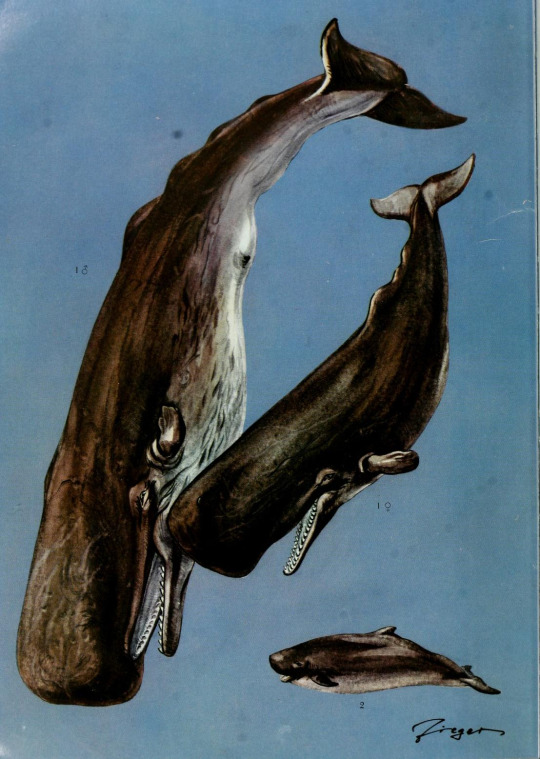
Grzimek's Animal Life Encyclopedia, vol. 11, Mammals II. 1972. Illustrated by Peter Barrett.
1.) Male and female sperm whales (Physeter macrocephalus)
2.) Pygmy sperm whale (Kogia breviceps)
298 notes
·
View notes
Text

Pygmy Sperm Whales (Kogia breviceps) are one of two extant species in the family Kogiidae. This shy whale is not much bigger than the average dolphin, growing to about 11 feet when fully grown. Pygmy Sperm Whales are rarely seen in the wild, due to their preference for deeper waters, in fact most of what we know about them comes from stranded specimens washed ashore.
#pygmy sperm whale#sperm whale#evolution#animals#animal art#art#whale evolution#whale#whales#cetacean#cetaceans#holocene#present day#zoology
5 notes
·
View notes
Photo
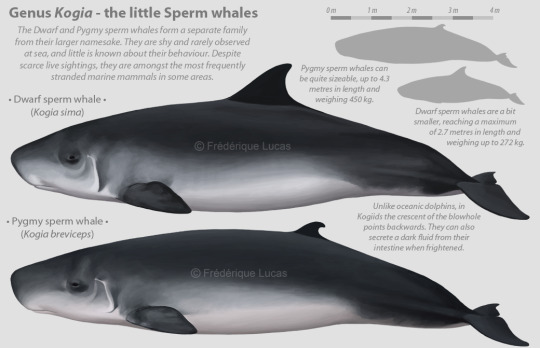
Genus Kogia - the little Sperm whales
And another infographic. I’m really liking this way of showing off work, feels a bit more visually appealing than just bare illustrations. This time it’s the turn of the mini sperm whales. Even though they look somewhat similar to Sperm whales, they are in a separate family, Kogiidae. It’s interesting how often they strand, given their low sighting rate at sea. They may simply be overlooked or misidentified: they tend to keep a low profile, and aren’t very demonstrative (though Dwarf sperm whales occasionally breach).
Even when stranded, the two species can be surprisingly difficult to identify. The most obvious difference lies in the size and position of the dorsal fin. A useful tool on ‘textbook’ individuals, but some animals have a relatively big/small dorsal fin for their species, positioned more in the middle. Another ID tool lies in their markings. Quite noticeable is the ‘false gill’ both these species have - a possible form of Batesian mimicry to look like a shark. In the Pygmy sperm whale this gill mark takes a sort of bracket shape, with a recurved bottom, while in the Dwarf it tends to be straight. There might be a slight difference in overall body markings as well, and from what I’ve seen Pygmies seem to have a somewhat longer head than Dwarfs, but this would be hard to use in the field. Interestingly, some Pygmy sperm whales turn up with more contrasting colouration and speckles all over. Perhaps older individuals? Also, both have these dark ‘eye patches’ which I think is very cute. I hope you enjoy and maybe learn something new about these mysterious whales!
#illustrations#scientific illustrations#Pygmy sperm whale#Kogia breviceps#Dwarf sperm whale#Kogia sima#Kogia#Kogiidae#sperm whale#breviceps#sima#digital art
90 notes
·
View notes
Text
Primitive Toothed Whales

This is a recreation of Kogiopsis floridana, a toothed whale that lived in the Miocene - Pliocene (12.5-2.5 mya) in what is now Florida, Georgia and the Carolinas. Little is known for sure about this cetacean species, as most of the data come from mandibles. Kogiopsis had very long teeth, 3–12.7 centimetres (1.2–5.0 in) long, without root. It was likely that this whale preyed upon animals such as squid, and perhaps pinnipeds.
The merit of identifying a new genus apart from the known Kogia genus was pointed out carefully by R. Kellogg in 1929:
Kogiopsis, new genus
DIAGNOSIS.-Skull unknown. Mandible incomplete, but symphysis estimated to comprise one-third of its length. In general conformation similar to corresponding portions of mandibles of Kogia, but differs in having broader symphysis, six instead of eight teeth on symphysial portion of ramus, alveoli not extending over so far on lateral surface of ramus, and in addition is much larger. Rami firmly ankylosed in region of symphysis; dorsal surface of symphysis rather broad and flat; lateral surfaces of rami slope to mid-line of ventral face of symphysis. Large alveoli located on upper outer edge or angle of mandible. Ten teeth in each mandible, of which six are lodged in symphysis. Teeth long (3 to 4 inches in length), somewhat curved, with small crowns, without distinct neck, and rather closely spaced. Outer surface of cement wrinkled and ornamented with coarse longitudinal grooves. Outer surface of internal cone of dentine encircled by fine ridges.
Kogiopsis floridana, new species
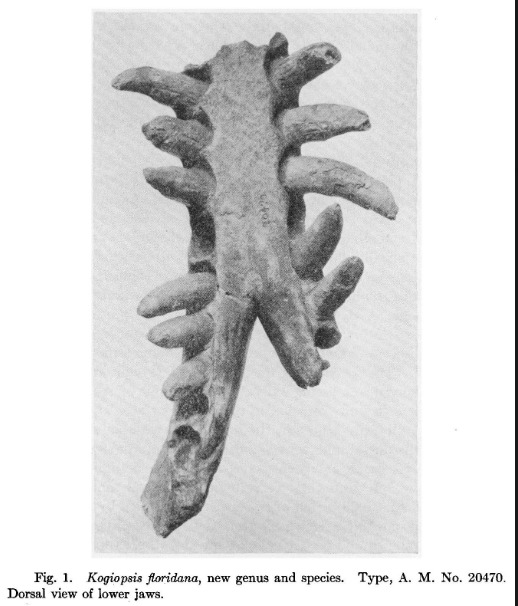
Not everyone is as convinced,
“We don't really know what Kogiopsis is, if it's a kogiid, physeterid, or stem physeteroid; further, all we have is a mandible with some teeth, so we don't know what it looked like externally.” - Boesse
The closest living relative is Kogia breviceps, also known as the pygmy sperm whale.
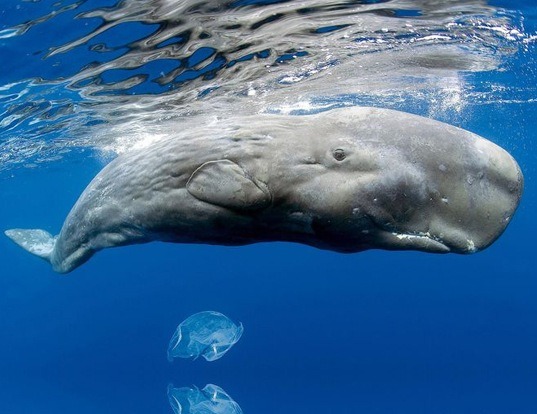
#who knows what it really looked like#kogiopsis floridana#kogia breviceps#miocene#fauna#cetacean#north america
2 notes
·
View notes
Photo
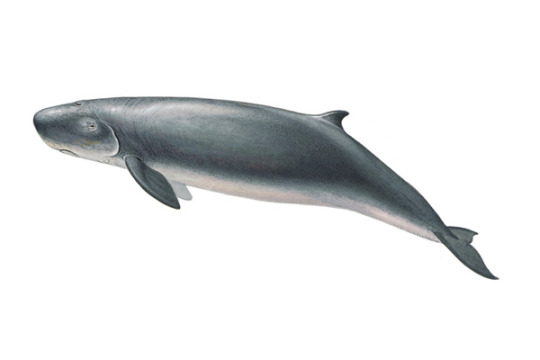
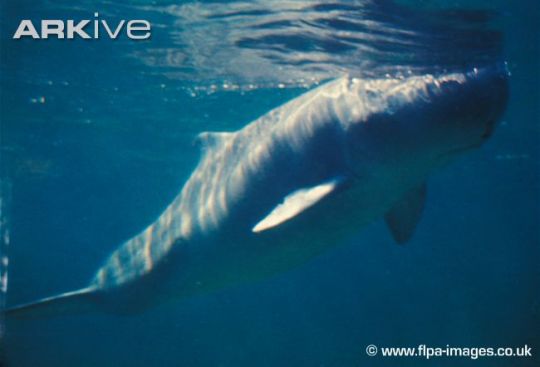

Pygmy sperm whale (Kogia breviceps)
Also known as: Kogia floweri, Kogia goodei, Kogia grayii, Physeter breviceps
Pygmy sperm whales are usually seen in small groups of six or fewer individuals, but there are few documented sightings. They tend to stay in deep water, beyond the continental shelf, and not much is known about their behavior. Although strandings are relatively frequent in the southeastern United States, sometimes because the whales have swallowed plastic bags, these animals are sighted so infrequently that they are considered uncommon for conservation purposes. Pygmy sperm whales are believed to feed mostly on cephalopods, and may mistake floating plastic bags for squid.
Classification
Animalia - Chordata - Mammalia - Eutheria - Boreoeutheria - Laurasiatheria - Scrotifera - Euungulata - Artiodactyla - Artiofabula - Cetruminantia - Whippomorpha - Cetacea - Odontoceti - Physeteroidea - Kogiidae - Kogiinae - Kogia - K. breviceps
Images: [x] [x] [x]
Source: [x]
#data deficient#pygmy sperm whale#kogia breviceps#sperm whale#whale#kogia#kogiinae#kogiidae#physeteroidea#odontoceti#cetacea#whippomorpha#cetruminantia#artiofabula#artiodactyla#boreoeutheria#eutheria#laurasiatheria#scrotifera#euungulata#mammalia#tetrapoda#vertebrata#chordata#species feature
2 notes
·
View notes
Text
Animal of the Day!
Pygmy Sperm Whale (Kogia breviceps)

Photo by Nelvin C. Cepeda)
Conservation Status- Least Concern
Habitat- Atlantic Ocean; Pacific Ocean
Size (Weight/Length)- 220 kg; 2 m
Diet- Squid; Fish; Shrimp
Cool Facts- The pygmy sperm whale is the much smaller cousin of the sperm whale. They are a toothed whale with teeth only on their bottom jaw. Pygmy sperm whales hunt using echolocation. These extremely high pitched noises cannot be heard by the human ear and are used to locate squid and fish. During these hunts, they are able to dive underwater for up to 45 minutes. Despite being able to dive a massive distance, small pods of pygmy sperm whales prefer to spend the majority of their time floating at the surface. Pygmy sperm whales are not illegally whaled like sperm whales, but threats such as boat strikes and nets do threaten their population.
Rating- 11/10 (Small, toothy critter.)
#Animal of the day#Animals#Mammals#Whales#Friday#March 4#Pygmy sperm whale#Sperm whale#biology#science#conservation#the more you know
40 notes
·
View notes
Photo
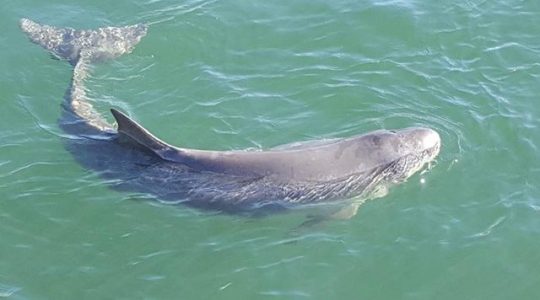


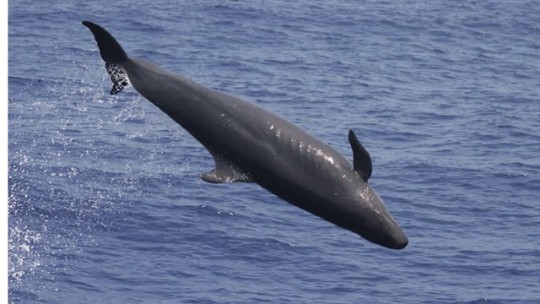



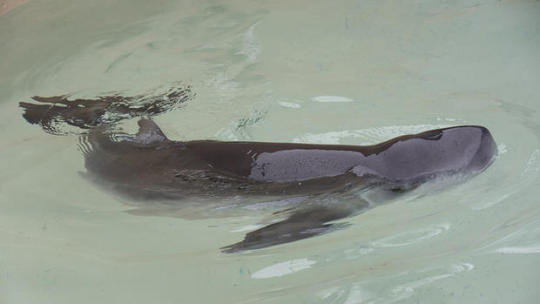


Size difference between Sperm Whale (blue), Pygmy Sperm Whale (green), Dwarf Sperm Whale (orange) and Human (black).
The dwarf sperm whale (Kogia sima) is a sperm whale that inhabits temperate and tropical oceans worldwide, in particular continental shelves and slopes. The species was considered to be synonymous with the pygmy sperm whale (Kogia breviceps) from 1878 until 1998. The dwarf sperm whale is a small whale, 6 ft 7 inches to 8 ft 10 inches long and 300 to 600 lbs, that has a gray coloration, square head, small jaw, and robust body. Its appearance is very similar to the pygmy sperm whale, distinguished mainly by the position of the dorsal fin on the body–nearer the middle in the dwarf sperm whale and nearer the back in the other.
The dwarf sperm whale is a suction feeder that mainly eats squid, and does this in small pods of typically 1 to 4 members. It is preyed upon by the killer whale and large sharks such as the great white shark. When startled, the whale can eject a cloud of red-brown fluid, similar to a squid. Most of what is known of the whale comes from beached individuals, as sightings in the ocean are rare. Many of these stranded whales died from parasitic infestations or heart failure.
The dwarf sperm whale has a dark-gray or blue-gray coloration with a lighter-gray underside, and a pale, crescent-shaped mark between the eye and the flipper, sometimes called a "fake gill," which is characteristic of the genus. Some individuals have been known to have a second crescent-shaped mark, creating a sort of pale ring encircling a darker spot. It has a high dorsal fin halfway down the length of the body, and two or more throat grooves. The dorsal fin is taller and closer to the head than it is in the pygmy sperm whale, and the back is flatter. It is not known to be sexually dimorphic.
Kogia is identified as having a square head, a small jaw with the snout jutting outward, and a porpoise-like build with a robust body that rapidly decreases towards the tail. They have the shortest snouts of any modern day whale. Characteristic of sperm whales, the left nostril is markedly larger than the right, and it has a spermaceti organ on its skull. The eyes are adapted for low-light environments. The dwarf sperm whale has 14 to 24 teeth, rarely 26, in the lower jaw that are sharp, slightly curved backwards, and–like other sperm whales–lack enamel. The teeth rarely exceed 1.2 inches in length, smaller than those of the pygmy sperm whale. At most, 6 teeth are in the upper jaws, though in modern sperm whales, upper teeth are defunct.
Unique to Kogia, there is a sac which hangs off from the small intestines near the anus that is filled with a dense, red-brown fluid that looks similar to chocolate syrup. When stressed, this fluid is released. This cloud can cover 100 m2 (1,100 sq ft) in the water.
The dwarf sperm whale ranges throughout tropical and temperate oceans of the world and inhabits the continental shelf and slope area. It seems to prefer warmer waters than the pygmy sperm whale. The dwarf sperm whale is one of the most commonly beached deep-diving whales in the world, though rarely seen at sea, and likewise, most information about the whale comes from examining beached individuals. Diving depth may vary from place to place: a study in the Bahamas placed average depth at around 820 ft, whereas a study in the deeper waters of Hawaii placed it at around 4,900 ft.
The dwarf sperm whale congregates into small pods of 1 to 4 individuals, though on occasion 10, likely due to limited food resources. Small group size and deep foraging grounds in the summer could also be anti-predator behaviors. The whale probably follows seasonal squid migrations from offshore in the summer to nearshore in the winter. It is possible it prefers a slope habitat as it allows the whale to herd squid against the wall, or it causes upwelling which the whale can ride on in order to save energy while hunting.
Kogia is thought to be slow-moving, rarely displaying rapid surfacing behavior, tending to float at the surface with only the nape and dorsal fin exposed. From the surface, they sink vertically, instead of lifting their tails out of the water to dive, which would create a splash.
There is some hunting of the dwarf sperm whale in Indonesian, Japan, Sri Lanka, and the Lesser Antilles as food or bait, though there are no major operations. A bigger threat is likely ingestion of marine debris and entanglement in fishing gear, though it has not been determined how serious a threat these pose. The IUCN currently lists the dwarf sperm whale's conservation status as data deficient, though it could possibly be least concerned.
189 notes
·
View notes
Text
Un vaso de plástico, posible causa de la muerte de otro cachalote aparecido en Malpica (Galicia) [GAL]
Esta semana aparecían dos ejemplares de cachalote pequeño (Kogia breviceps) en Malpica. Una hembra adulta muerta y su cachorro vivo. Fue un voluntario de CEMMA, José Manuel Pérez, quien los encontró por lo que rápidamente la Coordinadora activó un dispositivo coordinado con el ayuntamiento de Malpica para a atención a la cría. Hicieron cuanto pudieron, pero acabó muriendo. Según el CEMMA, durante la necropsia de la madre se comprobó la presencia de un vaso de plástico en el estómago que había causado lesiones en la pared.
etiquetas: malpica, cachalote, plástico, cemma, galicia, kogia breviceps
» noticia original (www.quepasanacosta.gal)
0 notes
Text
Xác cá voi quý hiếm dạt vào bãi biển
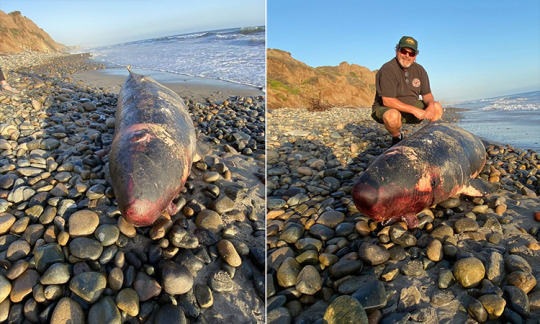
MỹMột con cá nhà táng nhỏ chết không rõ nguyên nhân được tìm thấy trên bãi biển San Onofre State ở phía nam bang California hôm 15/5.

Xác cá nhà táng nhỏ (Kogia breviceps) dạt vào bãi biển California. Ảnh: Jim Serpa.
"Con vật có một cái đầu lớn, vây lưng nhỏ xíu và hàm răng sắc nhọn như dao găm. Nó chính xác là một con cá nhà táng nhỏ", cựu giám sát viên bờ biển Jim Serpa mô tả khi lần đầu nhìn thấy xác cá voi. "Nó chỉ dài hơn 2,5 m và có một lỗ hổng kỳ lạ trên lưng, không giống lỗ thở ở bất kỳ con cá nhà táng nào".
Serpa nghi ngờ đó là vết đạn bắn và con vật có thể đã bị tấn công bởi những kẻ săn trộm. Tuy nhiên, các chuyên gia từ Cơ quan Khí quyển và Đại dương Quốc gia Mỹ (NOAA) cho hay cá nhà táng nhỏ là loài lặn sâu nên khả năng bị tấn công bởi một người có súng là rất thấp.
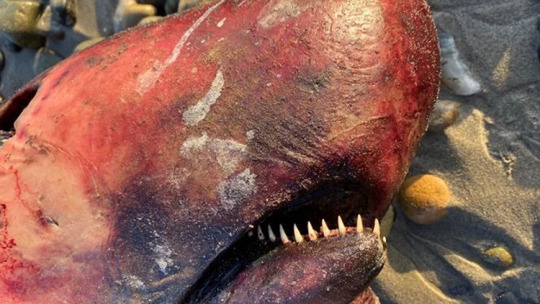
Mỗi con cá nhà táng nhỏ có khoảng 20 - 32 chiếc răng sắc nhọn dùng để săn mồi. Ảnh: Jim Serpa.
Kogia breviceps hiếm khi được quan sát thấy trong tự nhiên. Hầu hết thông tin mô tả về loài cho đến nay đều dựa trên những mẫu vật chết dạt vào bờ biển. Các nhà khoa học hiện vẫn không rõ có bao nhiêu con sinh sống ở vùng biển ngoài khơi California bởi chúng có xu hướng né tránh con người.
Cá nhà táng nhỏ là một trong hai loài còn tồn tại thuộc họ Kogiidae, bên cạnh cá nhà táng lùn. Chúng thường chỉ phát triển tới chiều dài 3,5 m và nặng khoảng 400 kg khi trưởng thành, lớn hơn không đáng kể so với cá heo. Loài này chủ yếu săn động vật chân đầu như mực và bạch tuộc.
Đoàn Dương (Theo Fox News)
from Tin mới nhất - VnExpress RSS https://ift.tt/2X6huPS
via IFTTT
0 notes
Photo
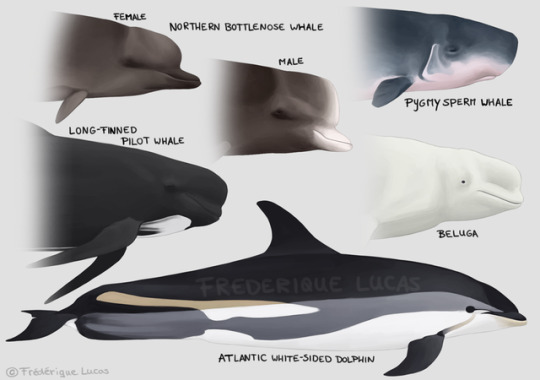
I’ve been so busy with the illustrations.. I all but forgot to keep you guys updated on them! Six new cetaceans have joined the ranks of the MARS (Marine Animal Response Society) commission: five bulb-headed friends and one beauty ;) Although, they’re all beautiful if you ask me.
Most species will be by represented by a single image, but a few have separate illustrations for males and females, when the sexes differ significantly from each other. The northern bottlenose whales here are the first example of such a species. Today it’ll be the turn of another beaked whale pair, and a third illustration featuring another species.
#wip#illustrations#Northern bottlenose whale#bottlenose whale#Hyperoodon ampullatus#hyperoodon#pygmy sperm whale#sperm whale#kogia breviceps#kogia#long-finned pilot whale#pilot watch#globicephala melas#globicephala#beluga whale#belug#delphinapterus leucas#Atlantic white-sided dolphin#white-sided dolphin#lagenorhynchus acutus#lagenorhynchus#dolphin#whale#mars#marine animal response society#canada#digital art#artists on tumblr
30 notes
·
View notes
Link
Deck: Marine Mammal Rescue Nantucket fills an important gap…Towns: NantucketTopic: NewsHub Category: OutdoorsAuthor: CapeCodToday StaffTeaser: Marine Mammal Rescue Nantucket fills an important gap…Main Image: Main Image Credit: Pictured: Pygmy sperm whale (Kogia breviceps) that beached and died on Nantucket's Cisco Beach on 12/25/2014. From right, Sgt. Keith Robinson, MA Environmental Police, Scott Leonard, and volunteer Cheryl Samsel.Thumbnail…
0 notes
Photo

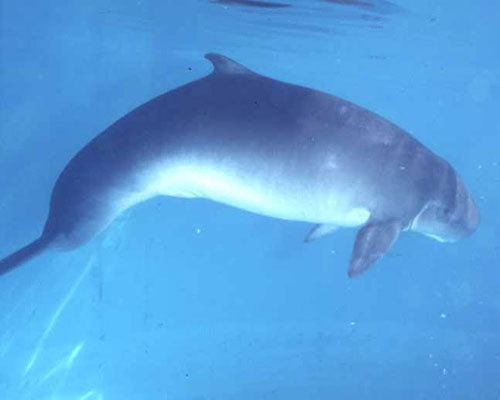

Dwarf sperm whale (Kogia simus)
The dwarf sperm whale inhabits temperate and tropical oceans worldwide, in particular continental shelves and slopes. It was first described by biologist Richard Owen, in 1866. The species was considered to be synonymous with K. breviceps from 1878 until 1998. Its appearance is very similar to the K. breviceps, distinguished mainly by the position of the dorsal fin on the body, which is nearer the middle on K. simus. The dwarf sperm whale is a suction feeder that mainly eats squid, and does this in small pods of typically 1 to 4 members. It is preyed upon by the killer whale and large sharks such as the great white shark. When startled, the whale can eject a cloud of red-brown fluid, similar to a squid. The dwarf sperm whale is hunted in small numbers around Asia. It is more threatened by ingesting or getting entangled by marine debris. No global population estimate has been made, and so its conservation status by the IUCN is data deficient.
Classification
Animalia - Chordata - Mammalia - Eutheria - Boreoeutheria - Laurasiatheria - Scrotifera - Euungulata - Artiodactyla - Artiofabula - Cetruminantia - Whippomorpha - Cetacea - Odontoceti - Physeteroidea - Kogiidae - Kogiinae - Kogia - K. simus
Images: [x] [x] [x]
Source: [x]
#data deficient#dwarf sperm whale#kogia simus#kogia#kogiinae#kogiidae#physeteroidea#odontoceti#cetacea#whippomorpha#cetrumminantia#artiofabula#artiodactyla#euungulata#scrotifera#laurasiatheria#boreoeutheria#eutheria#species feature#mammalia#tetrapoda#vertebrata#chordata
3 notes
·
View notes